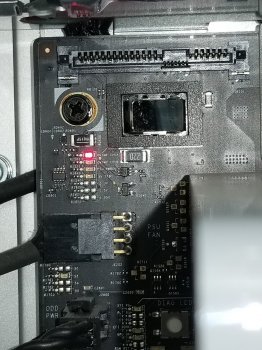Hey everyone, so I purchased a 2009 4,1 Mac Pro (Dual x5550) on Craigslist a couple weeks ago for $150. Honestly insane deal for how good of condition it's in. I painlessly flashed it to a 5,1, installed High Sierra, upgraded to 32gb of RAM, and installed a GTX 1070. I've had absolutely no problems with it at all until last night. It was sleeping and I went to wake it up by pressing the spacebar on the keyboard and the light on the front of the case just turned off, no noises or anything. It wouldn't boot up at all after that.
So I started troubleshooting. I unplugged the power cord (briefly saw the red diag CPU LEDs flash) for 15 seconds and then plugged it back in (CPU LEDs flashed again, but for a bit longer), tried booting it up but then again nothing happened. No click sounds, absolutely no signs of life. I then removed all HDDs, Optical drives, graphics card, and replaced the RAM with what the Mac Pro originally came with. I tried booting it up and once again nothing happened. I then pressed the DIAG button and I do see the 5V STBY light up.
Nothing I did seemed to fix the problem, so I basically gave up and left the Mac unplugged all night. About 20 hours later (now), I decided I would try and see if it would miraculously turn on, so I plugged the power cable in, pressed the button and the white light on the front of the case turned on and I heard a click... for about a second and then it shut off again. Now nothing I do will turn it on again.
Could someone possibly lead me in the right direction as to what part may be the culprit here? I really don't want to take it to a Mac Pro Specialist here in LA to get it diagnosed, and I certainly don't want to buy a Power Supply on a whim and hope that's the problem. Any help would be greatly appreciated, thanks!
So I started troubleshooting. I unplugged the power cord (briefly saw the red diag CPU LEDs flash) for 15 seconds and then plugged it back in (CPU LEDs flashed again, but for a bit longer), tried booting it up but then again nothing happened. No click sounds, absolutely no signs of life. I then removed all HDDs, Optical drives, graphics card, and replaced the RAM with what the Mac Pro originally came with. I tried booting it up and once again nothing happened. I then pressed the DIAG button and I do see the 5V STBY light up.
Nothing I did seemed to fix the problem, so I basically gave up and left the Mac unplugged all night. About 20 hours later (now), I decided I would try and see if it would miraculously turn on, so I plugged the power cable in, pressed the button and the white light on the front of the case turned on and I heard a click... for about a second and then it shut off again. Now nothing I do will turn it on again.
Could someone possibly lead me in the right direction as to what part may be the culprit here? I really don't want to take it to a Mac Pro Specialist here in LA to get it diagnosed, and I certainly don't want to buy a Power Supply on a whim and hope that's the problem. Any help would be greatly appreciated, thanks!


